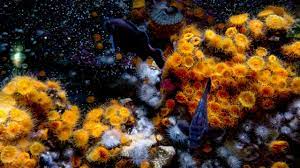Healthy reefs have a rich soundscape. “Lots of the invertebrates and the fishes make weird and wonderful noises for all sorts of weird and wonderful reasons. When you take recordings, you hear all these pops and buzzes and trills and whoops,” says Tim Lamont, a marine biology research fellow at the University of Exeter. A degraded reef, on the other hand, has less life milling about and is therefore much quieter. “If you’re in the business of ecosystem restoration, being able to create coral reefs that sound good is a really good thing to be, ” Lamont explains.
Lamont and his colleagues have been interested in studying the relationship between sounds and underwater life. But it’s by no means an easy process. Oftentimes, it requires a human touch to clean up the background noise in the recordings, annotate the audio, and mark all the distinct sounds. And while there’s been some attempts to automate this task, many technical limits still remain.
This became evident in a recent collaboration with Mars Inc., which reached out and asked them to use soundscape ecology to monitor the progress of their reef restorations. (The chocolate and pet food corporation has been collaborating with scientists and local communities to rehabilitate damaged coral habitats around the world as part of its larger effort to offset some of its negative environmental impacts. Mars also partly funded this recent soundscape project.) The corresponding study on the effort, published this week in the Journal of Applied Ecology, found that by the sound of it, Indonesian reefs damaged by blast fishing recovered nicely after restoration efforts.
Coastal communities rely on coral reefs for food and more. When these structures fall apart due to human activities like fishing with dynamite, they can have devastating effects on the people that depend on them for a livelihood. Since these reefs have slow natural recovery rates, restoring the coral, which forms the foundation of these ecosystems, could bring back fish and other marine life. But it’s not always so easy to judge whether habitat restorations will take or not. “It’s a different thing to garden a couple of corals than it is to bring back an entire ecosystem,” says Lamont. Outside of checking whether coral regrows, ecologists have to test if the new reefs can support marine life, dampen wave energy, control carbonate budgets, and provide sustenance for coastal communities.
That’s where soundscape analyses come in. They’re a promising indicator of overall ecosystem diversity because they can detect more critters than images and visual observation; for instance, biologists can hear fishes that are otherwise hidden or are well-camouflaged. Plus, with sound, experts can monitor the habitats around the clock. “There are different things that you can measure about the soundscape,” Lamont says. “You can measure how complex it is, how loud it is, how variable it is through time, or how variable it is at different pitches through frequency bands.”
Source : https://www.popsci.com/technology/analyzing-reef-soundscapes/







